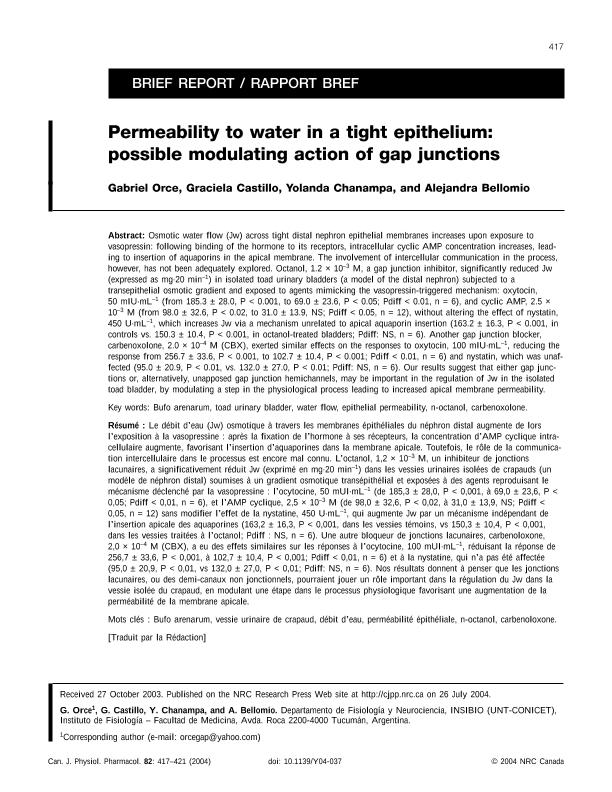Artículo
Osmotic water flow (Jw) across tight distal nephron epithelial membranes increases upon exposure to vasopressin: following binding of the hormone to its receptors, intracellular cyclic AMP concentration increases, leading to insertion of aquaporins in the apical membrane. The involvement of intercellular communication in the process, however, has not been adequately explored. Octanol, 1.2 × 10-3 M, a gap junction inhibitor, significantly reduced Jw (expressed as mg·20 min-1) in isolated toad urinary bladders (a model of the distal nephron) subjected to a transepithelial osmotic gradient and exposed to agents mimicking the vasopressin-triggered mechanism: oxytocin, 50 mIU·mL-1 (from 185.3 ± 28.0, P < 0.001, to 69.0 ± 23.6, P < 0.05; Pdiff < 0.01, n = 6), and cyclic AMP, 2.5 × 10-3 M (from 98.0 ± 32.6, P < 0.02, to 31.0 ± 13.9, NS; Pdiff < 0.05, n = 12), without altering the effect of nystatin, 450 U·mL-1, which increases Jw via a mechanism unrelated to apical aquaporin insertion (163.2 ± 16.3, P < 0.001, in controls vs. 150.3 ± 10.4, P < 0.001, in octanol-treated bladders; Pdiff: NS, n = 6). Another gap junction blocker, carbenoxolone, 2.0 × 10-4 M (CBX), exerted similar effects on the responses to oxytocin, 100 mIU·mL-1, reducing the response from 256.7 ± 33.6, P < 0.001, to 102.7 ± 10.4, P < 0.001; Pdiff < 0.01, n = 6) and nystatin, which was unaffected (95.0 ± 20.9, P < 0.01, vs. 132.0 ± 27.0, P < 0.01; Pdiff: NS, n = 6). Our results suggest that either gap junctions or, alternatively, unapposed gap junction hemichannels, may be important in the regulation of Jw in the isolated toad bladder, by modulating a step in the physiological process leading to increased apical membrane permeability. Le débit d’eau (Jw) osmotique à travers les membranes épithéliales du néphron distal augmente de lors l’exposition à la vasopressine : après la fixation de l’hormone à ses récepteurs, la concentration d’AMP cyclique intracellulaire augmente, favorisant l’insertion d’aquaporines dans la membrane apicale. Toutefois, le rôle de la communication intercellulaire dans le processus est encore mal connu. L’octanol, 1,2 × 10–3 M, un inhibiteur de jonctions lacunaires, a significativement réduit Jw (exprimé en mg·20 min–1) dans les vessies urinaires isolées de crapauds (un
modèle de néphron distal) soumises à un gradient osmotique transépithélial et exposées à des agents reproduisant le mécanisme déclenché par la vasopressine : l’ocytocine, 50 mUI·mL–1 (de 185,3 ± 28,0, P < 0,001, à 69,0 ± 23,6, P <
0,05; Pdiff < 0,01, n = 6), et l’AMP cyclique, 2,5 × 10–3 M (de 98,0 ± 32,6, P < 0,02, à 31,0 ± 13,9, NS; Pdiff <0,05, n = 12) sans modifier l’effet de la nystatine, 450 U·mL–1, qui augmente Jw par un mécanisme indépendant de l’insertion apicale des aquaporines (163,2 ± 16,3, P < 0,001, dans les vessies témoins, vs 150,3 ± 10,4, P < 0,001, dans les vessies traitées à l’octanol; Pdiff : NS, n = 6). Une autre bloqueur de jonctions lacunaires, carbenoloxone, 2,0 × 10–4 M (CBX), a eu des effets similaires sur les réponses à l’ocytocine, 100 mUI·mL–1, réduisant la réponse de
256,7 ± 33,6, P < 0,001, à 102,7 ± 10,4, P < 0,001; Pdiff < 0,01, n = 6) et à la nystatine, qui n’a pas été affectée (95,0 ± 20,9, P < 0,01, vs 132,0 ± 27,0, P < 0,01; Pdiff: NS, n = 6). Nos résultats donnent à penser que les jonctions lacunaires, ou des demi-canaux non jonctionnels, pourraient jouer un rôle important dans la régulation du Jw dans la vessie isolée du crapaud, en modulant une étape dans le processus physiologique favorisant une augmentation de la perméabilité de la membrane apicale.
Permeability to water in a tight epithelium: Possible modulating action of gap junctions
Fecha de publicación:
06/2004
Editorial:
National Research Council Canada-NRC Research Press
Revista:
Canadian Journal Of Physiology And Pharmacology
ISSN:
0008-4212
e-ISSN:
1205-7541
Idioma:
Inglés
Tipo de recurso:
Artículo publicado
Clasificación temática:
Resumen
Archivos asociados
Licencia
Identificadores
Colecciones
Articulos(INSIBIO)
Articulos de INST.SUP.DE INVEST.BIOLOGICAS
Articulos de INST.SUP.DE INVEST.BIOLOGICAS
Citación
Orce, Gabriel Guillermo F.; Castillo, Graciela Alicia; Chanampa, Yolanda; Bellomio, Augusto; Permeability to water in a tight epithelium: Possible modulating action of gap junctions; National Research Council Canada-NRC Research Press; Canadian Journal Of Physiology And Pharmacology; 82; 6; 6-2004; 417-421
Compartir
Altmétricas




